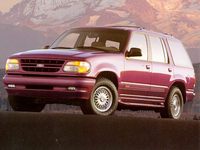New Car Review
1995 FORD EXPLORER LIMITED 4x4 SPORT UTILITY VEHICLE
by: BILL RUSS
SEE ALSO: Ford Buyer's Guide
Ford brought out its Explorer series of sport utility vehicles about five years ago, and in this short period of time it has become the best seller in its class in the U.S. To illustrate the impact of Sport Utility Vehicles on the American motor vehicle market their sales started at under 40,000 units in 1982 and expanded to almost 1,200,000 units in 1993, an increase of 300 percent in only 11 years!
While many of the sport utility vehicles are equipped with four-wheel drive it is estimated that only about three percent ever actually go "off road". Buyers don't really think of them as trucks, although that's what they are from a legal standpoint. Major sales have been to car buyers who are switching over to SUVs or minivans. There are many factors for their popularity, including their versatile utility, their lifestyle statement, and their commanding view of the road. Women as well as men appreciate sport-utilities. A study indicates that the three most common uses for these multipurpose vehicles are the same as for cars: shopping and errands, pleasure driving and commuting.
For 1995 many significant changes have been made to the Explorer line at a cost of over one billion dollars. It includes a new production line in St. Louis to allow Ford to build an additional 135,000 units annually, for a total of 445,000 Explorers. Additionally, many new revisions have been made to the Explorer to refine its styling, construction, conveniences, safety and handling. Our test covered the top-of-the-line Explorer Limited which is very fully and luxuriously equipped.
APPEARANCE: The Explorer Limited Edition is a handsome piece of machinery. It would be a shame to take anything this nice up the Rubicon, but, as an upscale station wagon with a rough-and- ready but refined look, it does just fine. The newest Explorer is rounded and looks a bit larger than its predecessor. The chromeless front is dominated by a massive body colored bumper and grille plus integrated headlights and turn signals. Wide, aero-styled mirrors, running boards, and a broad bumper strip add style to the sides and perform a useful function. A roof rack adds more style and carrying capacity, wile specially styled wheels and large rugged off-road tires hint at its off-road capability
COMFORT: The interior layout reinforces the near-luxury car feeling. It has all of the expected comforts and conveniences and then some, including an optional handy CD cassette changer located in the center console to augment the powerful Ford Electronics JBL AM/FM/cassette audio system. The leather-faced seats are luxury-car plush. In front the six-way power bucket ones have a memory setting switch, while the ones in back have an adjustable back and fold down in a 60/40 split to accommodate extra cargo. Rear-seat passengers have separate controls for the air-conditioning and sound systems. An efficient climate control system keeps the cabin at a comfortable temperature. An overhead console has a compass and outside temperature readout, while the message center reports on some 30 vehicle conditions.
SAFETY: The new Explorer has both driver's and passenger's-side air bags. Four-wheel antilock disc brakes, height-adjustable shoulder straps, child-proof rear door locks, side-impact protection beams and a strongly supported steel ladder frame are all standard equipment on every Explorer.
ROADABILITY: Except for the high stance and consequent excellent visibility, the Explorer feels much like a top-level domestic sedan on the road. It is mechanically quiet, with a distinct lack of old- days sport-utility gear and tire noise. There is very little wind noise. Not only does the Explorer have the creature comforts of a top-notch sedan, it has the ride comfort, too. Major revisions to the chassis and front suspension pay major dividends on and off the road. A stiffer frame and new independent front suspension and rack-and-pinion steering make the Explorer track straight on the highway without any wandering. When needed, four-wheel drive on the Explorer Limited can be selected with a rotary switch on the dashboard.
PERFORMANCE: The 4-liter, 160 horsepower German built V6 engine has a more sophisticated electronic control module this year. It can be matched to a five-speed manual or four-speed automatic transmission. We chose the automatic. It worked well with the engine and shifted smoothly. The Explorer has no problem keeping up with traffic. Suitably equipped, it can tow 5000 pounds.
CONCLUSIONS: Sport-utility vehicles keep on growing in popularity and the newest Ford Explorer Limited Edition shows why. It is the luxury estate wagon for the Nineties.
SPECIFICATIONS:
1995 FORD EXPLORER LIMITED 4x4 SPORT UTILITY VEHICLE
Base Price $ 33,935
Price As Tested $ 35,915
Engine Type V-6, ohv - pushrod, mpfi
Engine Size 4.0 liter/244 cid
Horsepower 160 @ 4200
Torque (ft/lbs) 225@ 2800
Wheelbase/Length 112"/189"
Transmission four-speed ECautomatic w/overdrive
Curb Weight 4200
Pounds per Horsepower 26
Fuel Capacity 21
Fuel Requirement Unleaded regular (87 oct)
Tires Goodyear Wrangler RTS P235/75R15 M+S
Brakes antilock-standard vented disc/disc
Drive Train Front engine/rear drive/part time 4x4
Towing Capacity (4x2) 4800 lbs
PERFORMANCE
(in two-wheel drive)
EPA Economy - miles per gallon
city/highway/observed 15/20/17.4
0 to 60 mph 10.9 sec
1/4 mi (E.T.) 18.4 sec
Coefficient of Drag (Cd) .43



